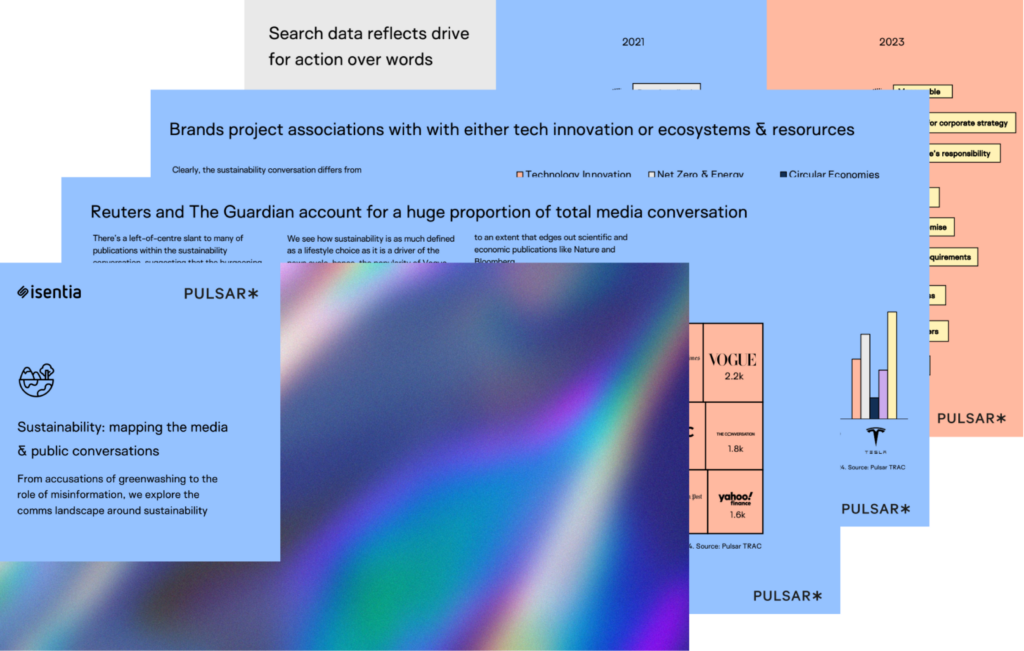It’s become a truism to state that local journalism is in decline. But that story has been complicated by a new form of socially conscious ‘start-up’ publication cropping up across both ANZ and the wider world.
Consumers of local journalism are turning to independent sources, such as CityHub and Westender, that focus on community-driven stories, accountability, and underrepresented voices. This shift is compounded by the decline of traditional outlets, as highlighted in recent articles discussing the closure of regional papers due to rising costs, Meta’s withdrawal of funding, and shrinking government ad budgets. These pressures reinforce the need for meaningful engagement with local journalism, as audiences demand authenticity and transparency in coverage of issues like housing, civil rights, and activism. By examining these independent outlets, we gain insights into how independent journalism continues to shape public discourse and meet the expectations of news consumers today.
Over time, the ANZ media has itself been writing increasingly about local journalism. Some of this laments its decline; elsewhere, it’s cited in national stories as a story source. But over time, we also see some of that attention focusing on publications such as The Westender and Cityside.
The Westender’s content and engagement reveals that local journalism consumption in Brisbane is significantly influenced by timely and relevant political topics, and pressing community issues such as the housing crisis.
Engagement patterns suggest that timely advocacy and local relevance are key draws for the publication, highlighting a community eager for information that resonates with their values and interests.
Barnaby Joyce abstained when voting to bring Assange home. Bridget Archer was the only liberal to cross the floor
— BornIn54 (@Born_In_54) June 25, 2024
Barnaby Joyce is full of shit, piss and wind.https://t.co/Ix37kYhwJo
Solving Brisbane’s housing crisis. – Westenderhttps://t.co/qXcAcN6vLB#insiders
— Jan Bowman 🌈 (@JanB_QLD) February 17, 2024
Over in Sydney, meanwhile, CityHub amplifies underrepresented voices and promotes accountability by covering issues such as military bases (“We Need to Talk About Pine Gap”), NSW’s anti-protest laws, and housing policies. It offers alternative perspectives that challenge mainstream narratives, fostering civic engagement and activism. With audiences engaging on platforms like X and Reddit, local outlets build credibility through community-driven stories and partnerships with organisations like Australians For War Powers Reform.
This pattern suggests that certain topics resonate more deeply with the audience than others. Stories that receive particular attention advocate for diversity and anti-racism, and frequently call out local councils for failing to act on commitments, such as anti-racism strategies.
CityHub highlights the views of prominent local figures and groups, like Greens councillor Dylan Griffiths, who pushed for Inner West Council’s ceasefire call in Gaza, and the Arab Council for Australia, whose frustration led to the mass resignation of the Multicultural Advisory Committee. This type of reporting offers a platform for communities seeking to impact policy—something often underrepresented in mainstream media coverage unless it’s taking place on national scale.
Solidarity is a verb! ✊🏾
— Nasser Mashni (@iamthenas) November 23, 2023
Mass resignation!
Thank you everyone at @IWCouncil Multicultural Advisory Committee 🙏🏾 you are all awesome!@ChrisMinnsMP @AlboMP @SenatorWonghttps://t.co/EYFAQQuxil
.@tzedekcollectiv says that irresponsible media used the Bondi massacre to further antisemitism & Islamophobia, & circulation of both are expedient to the political goals of Zionism. Read more here: https://t.co/ie3KG46Cz7
— naama (@derridalicious) April 16, 2024
I can understand how those who didn't know @AlboMP style of politics well could be bitterly disappointed. But those who've experienced his politics for decades less so. Read my taste of how his exstaffer Mayor Byrne runs #IWC which he controls https://t.co/7oLgJIZDR9
— Wendy Bacon (@Wendy_Bacon) August 26, 2024
The active sharing of CityHub content on platforms like X and Reddit highlights community engagement around social issues.
CityHub’s audience is most likely to engage with political themes, followed by culture and crime, often focusing on issues that directly impact their lives, values, and beliefs.
Advocacy campaigns, such as the Fossil Ad Ban’s billboard initiative, not only spotlight important issues but also critique political figures like Anthony Albanese based on their responsiveness to these values. Cultural expressions, such as protests and street performances, carry political significance, while initiatives like the Sydney Olympic Park development reflect community values towards topics like urban planning.
Clearly, CityHub and publications like it are fulfilling a need that has been unfulfilled amongst the community – but what influential figures help disseminate these stories amongst willing audiences?
It’s no surprise that advocacy groups are actively sharing and disseminating calls to action. Content creators, particularly those writing for CityHub, effectively communicate the stories they cover, resulting in increased engagement for the local outlet. The reach and influence of these reporters often surpass that of CityHub itself. Additionally, credible community figures, such as university lecturers, further enhance the publication’s coverage.
CityHub and The Westender illustrate the critical role of independent local journalism in shaping public dialogue and accountability. This active participation reflects a community eager for accountability and willing to challenge local authorities on issues like systemic inequalities and inadequate policies. The preference for independent sources indicates growing scepticism towards mainstream media and a trust in alternative narratives that align with their beliefs.
” [“post_title”]=> string(62) “How a new type of local journalism is engaging ANZ audiences ” [“post_excerpt”]=> string(0) “” [“post_status”]=> string(7) “publish” [“comment_status”]=> string(4) “open” [“ping_status”]=> string(4) “open” [“post_password”]=> string(0) “” [“post_name”]=> string(60) “how-a-new-type-of-local-journalism-is-engaging-anz-audiences” [“to_ping”]=> string(0) “” [“pinged”]=> string(0) “” [“post_modified”]=> string(19) “2024-10-18 01:52:12” [“post_modified_gmt”]=> string(19) “2024-10-18 01:52:12” [“post_content_filtered”]=> string(0) “” [“post_parent”]=> int(0) [“guid”]=> string(32) “https://www.isentia.com/?p=35151” [“menu_order”]=> int(0) [“post_type”]=> string(4) “post” [“post_mime_type”]=> string(0) “” [“comment_count”]=> string(1) “0” [“filter”]=> string(3) “raw” }Blog
How a new type of local journalism is engaging ANZ audiences
It’s become a truism to state that local journalism is in decline. But that story has been complicated by a new form of socially conscious ‘start-up’ publication cropping up across both ANZ and the wider world. Consumers of local journalism are turning to independent sources, such as CityHub and Westender, that focus on community-driven stories, […]
The role –and nature– of news and journalism is constantly evolving, from how it is consumed to which voices are trusted. New platforms, the rise of citizen journalists, and shifting news consumption habits are continuing to reshape the traditional and new media landscapes, creating both challenges and opportunities for PR and communications professionals.
In regions like Australia and New Zealand (ANZ), these challenges are particularly significant due to the unique ecosystem and levels of public engagement. With a relatively small number of major news outlets, the way journalism is practiced and perceived in ANZ carries considerable weight.
And this has a day-to-day impact on how PR & Comms professionals carry out their jobs. What does it mean when trust in journalism fluctuates, or when emerging platforms challenge traditional outlets for influence?
To kick off our study into the state of journalism and news – in both ANZ and beyond – we’ve started by quantifying how the public talk about the media.
Compared to the UK and US, Australia and New Zealand audiences are more likely to label journalism as ‘important’, albeit with a not inconsiderable amount of conversation describing it as “dead.”
What’s behind the difference? Certainly, both countries’ audiences advocate for quality reporting and accountability, as exemplified by New Zealand journalist Jack Tame’s revelation of a gun lobbyist’s lies after the Christchurch attack. At the same time, local journalism faces challenges, with regional outlets shutting down due to lack of government funding, as noted by ACM’s Managing Director Tony Kendall. These in turn lead to spirited defenses of local journalism’s importance.
However, neither of these trends are necessarily unique to the ANZ regions. The answer can potentially be located when we look at how these conversations take place over time.
Clearly, public conversations around journalism – both in ANZ and elsewhere – are not in their nature consistent. This reflects how particular moments in the news cycle can lead to a sudden outpouring of interest and conversation.
So what are those moments in ANZ?
One centres on the recent court cases being mediated between the Australian government and social media organisations. In looking to place a monetary and moral value on news, these proceedings prompt the ANZ public and media to talk about journalism as something ‘important’ and worth protecting.
Another hinges around the return of Julian Assange to Australian soil. This has prompted differing responses across individuals and media outlets – but what’s certain is that it places ANZ at the centre of an important unfolding conversation about the role and responsibilities of the media.
Australia and New Zealand are global outliers in many sectors, from sport to mining & energy. Journalism, it seems, is another that could reasonably be added to that list.
Huh?
— Tom Falkingham (@TFalkingham) July 14, 2024
Journalists are victims of hackers like Assange too?
Because his journalism humiliated all our journalists?
Isn't that the point?
It's hilarious being told how critically important journalism is by uncritical fucks who haven't done any because they don't even know wtf it is!
Companies such as Meta do not respond to undergraduate zingers. They respond to strength. It is well past time that the government acts. The future of Australian journalism is at stake: https://t.co/8OcQt1WnHH pic.twitter.com/aHi00rp9bf
— The Australian (@australian) September 16, 2024
So why does this matter?
PR and communications strategies must adapt to a landscape where sources of information are more fragmented and where citizens themselves can act as newsmakers. It’s important to understand how attitudes around these vital channels and contacts take shape.
We’ll be exploring the journalist and media landscape through multiple different lenses over the coming couple of months. If you’d like to attend one of the events we’re hosting around the region – or view a webinar recording – please reach out to us at brandmarketing.team@isentia.com
” [“post_title”]=> string(51) “ANZ audiences & journalism: A sunnier outlook ” [“post_excerpt”]=> string(0) “” [“post_status”]=> string(7) “publish” [“comment_status”]=> string(4) “open” [“ping_status”]=> string(4) “open” [“post_password”]=> string(0) “” [“post_name”]=> string(42) “anz-audiences-journalism-a-sunnier-outlook” [“to_ping”]=> string(0) “” [“pinged”]=> string(0) “” [“post_modified”]=> string(19) “2024-10-18 01:51:45” [“post_modified_gmt”]=> string(19) “2024-10-18 01:51:45” [“post_content_filtered”]=> string(0) “” [“post_parent”]=> int(0) [“guid”]=> string(32) “https://www.isentia.com/?p=35056” [“menu_order”]=> int(0) [“post_type”]=> string(4) “post” [“post_mime_type”]=> string(0) “” [“comment_count”]=> string(1) “0” [“filter”]=> string(3) “raw” }Blog
ANZ audiences & journalism: A sunnier outlook
The role –and nature– of news and journalism is constantly evolving, from how it is consumed to which voices are trusted. New platforms, the rise of citizen journalists, and shifting news consumption habits are continuing to reshape the traditional and new media landscapes, creating both challenges and opportunities for PR and communications professionals. In regions […]
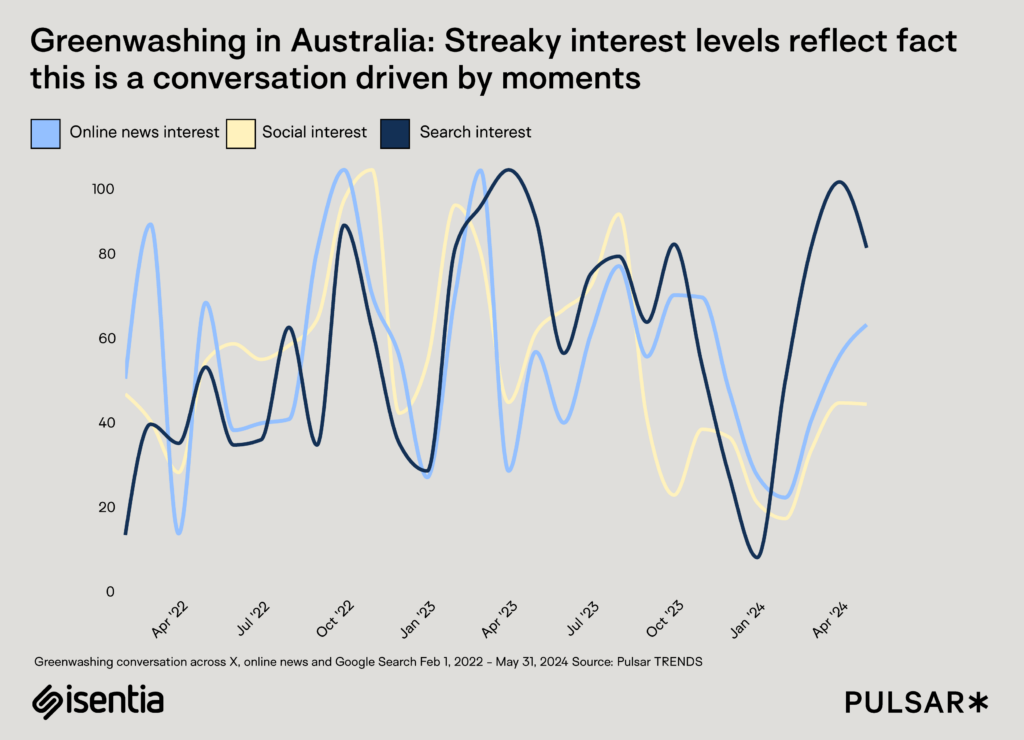

Social media data is decreasing while online news activity re-engages, indicating incident-led conversations. Regulatory bodies like the ACCC, and state and federal governments are tackling greenwashing by identifying major corporate offenders and their misleading actions, such as ‘recyclable’ packaging, carbon credit misuse, lack of transparency in fossil fuel investments, and exploitation of government climate programs. Audience conversations often align with news coverage on these matters.
The term in Australia particularly gained traction among social audiences around November 2022 when the UN called out the Australian government for allowing the use of carbon offsets in corporate emissions reduction strategies. News of the apparent collusion between the government and large corporations has caused public faith and trust in both to dwindle. As these stories emerge, Australia’s positive sustainability impact on the international stage is significantly undermined.
Powerful story by @joe_hinchcliffe in @guardian this weekend. We cannot afford new coal mining given the climate crisis and the pressure on our iconic #GreatBarrierReef #ClimateActionNow https://t.co/Q64tPjQAHT
— Jane Garcia (@janegarcia) November 13, 2022
When we look at which sectors are most discussed within the greenwashing topic, energy, finance, and food take the lead.
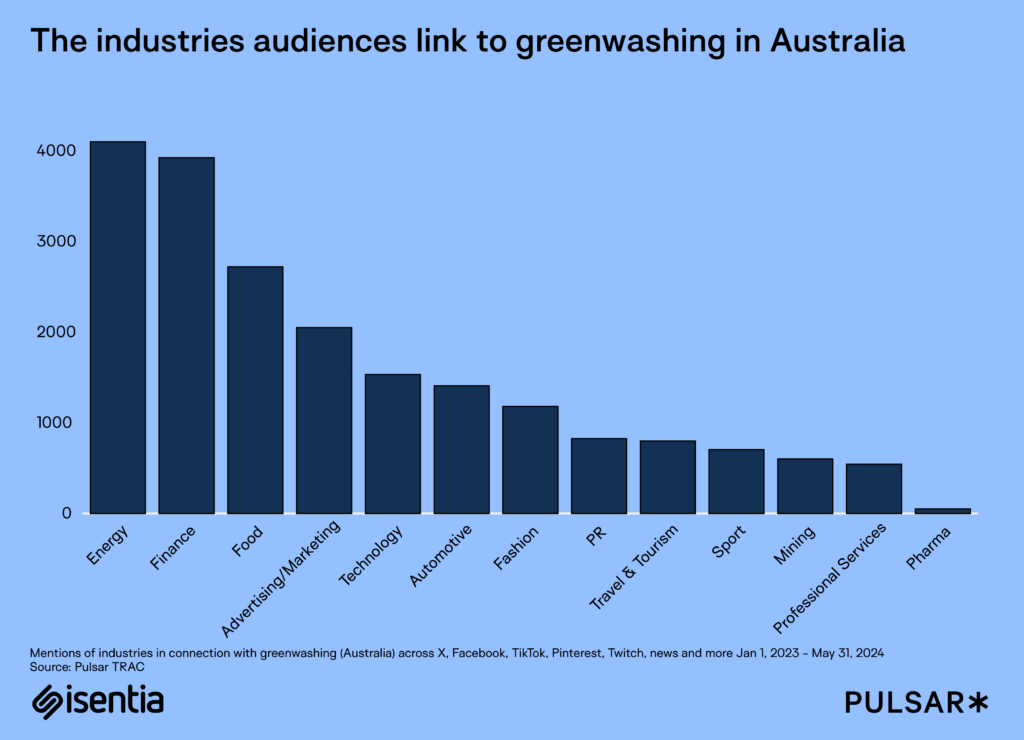

Much of the discussion regarding the energy and finance sectors emphasises their interconnectedness, particularly the investment by financial institutions, including super funds, in environmentally harmful industries. Despite some super funds claiming to offer options that avoid unsustainable investments, reports have revealed that they collectively hold millions of shares in the fossil fuel industry.
Many industries are being criticised for using carbon credits, such as REDD+ offsets, to appear more sustainable. Advertising, marketing, and public relations also play a significant role in promoting misleading sustainability initiatives, thereby contributing to greenwashing. However, stakeholders are aware that the advertising and communications industries have a huge impact on the profitability and success of an industry or product. The European Union’s Product Environmental Footprint classification system, for example, has been criticised by Australia’s wool industry for being unfair to wool products and for greenwashing. This, they argue, not only undermines the pursuit of a green transition within fashion but also damages a vital industry.
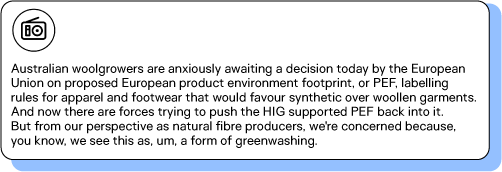

Mercer stands out as a most mentioned brand within the topic of greenwashing. This is due to ASIC pursuing a civic penalty case against them which alleged they misled members about its sustainability investments. This is groundbreaking for audiences to witness as it would be the first time the consumer watchdog has taken a company to court for alleged greenwashing.
Australian Securities & Investments Commission sues Mercer Super in first greenwashing case alleging members of Sustainable Plus fund misled by claims carbon intensive fossil fuels excluded but it had invested in 15 stocks including AGL Energy, BHP, Glencore and Whitehaven Coal
— Bill Hare (@BillHareClimate) February 28, 2023
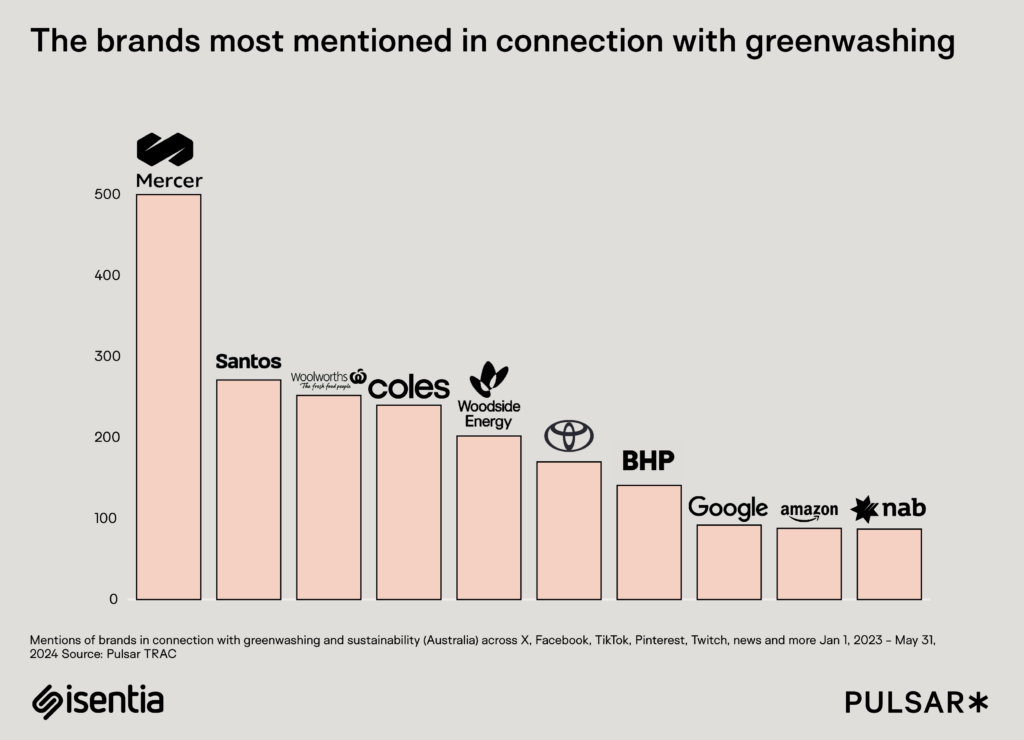

Much of the conversation focuses on misinformation and lack of transparency in communication and marketing. Certifications like Fair Trade are being questioned, particularly for products like chocolate, and eco-certification for farmed salmon. It particularly muddies the waters for political figures when they get entangled with brands coming under scrutiny for such greenwashing.
‘No word has been more readily purloined for greenwashing than “sustainable”, but Tassal does it with particular flair. Getting Australia’s PM to rig up as its advertising board was a corporate coup.’
— Dr Josie McSkimming 🌳🌈🌿🕸 (@JosieMcskimming) January 26, 2024
All the salmon farms are overseas owned.
-Bob Brown https://t.co/acQUH1vqgS
Furthermore, some companies feature in the media conversation due to their involvement in a senate enquiry initiated in March 2023, with a report expected by June 28th this year.
Analysis of the ANZ reveals a shift in mindset, with consumers emphasising individual actions for solutions like composting or guerilla campaigns on mislabelled environmentally friendly salmon products. Grassroots and individual activism leading to actions like divestment from conflicting companies. Community groups like uni student clubs showcase how groups with shared values and experiences can make noise and incite change with how universities invest. However, there are ongoing debates as to whether it’s the role of sectors like higher education or Super Funds to prioritise the environmental implications of their decisions.
The rise in curiosity around greenwashing highlights the growing consumer demand for transparency and genuine sustainability from brands. As regulatory scrutiny and public awareness increase, brands must ensure their sustainability claims are genuine or face reputation damage.
” [“post_title”]=> string(76) “The Eco-Spin Cycle: how brand’s sustainability claims come out in the wash” [“post_excerpt”]=> string(139) “Regulators are cracking down on corporate greenwashing, but what does media discussion reveal about its impact on brand-consumer relations?” [“post_status”]=> string(7) “publish” [“comment_status”]=> string(4) “open” [“ping_status”]=> string(4) “open” [“post_password”]=> string(0) “” [“post_name”]=> string(72) “the-eco-spin-cycle-how-brands-sustainability-claims-come-out-in-the-wash” [“to_ping”]=> string(0) “” [“pinged”]=> string(88) ” https://www.isentia.com/latest-reads/sustainability-mapping-media-and-pr-conversations/” [“post_modified”]=> string(19) “2024-09-09 02:35:11” [“post_modified_gmt”]=> string(19) “2024-09-09 02:35:11” [“post_content_filtered”]=> string(0) “” [“post_parent”]=> int(0) [“guid”]=> string(32) “https://www.isentia.com/?p=32225” [“menu_order”]=> int(0) [“post_type”]=> string(4) “post” [“post_mime_type”]=> string(0) “” [“comment_count”]=> string(1) “0” [“filter”]=> string(3) “raw” }Blog
The Eco-Spin Cycle: how brand’s sustainability claims come out in the wash
Regulators are cracking down on corporate greenwashing, but what does media discussion reveal about its impact on brand-consumer relations?
As the spotlight on sustainability intensifies year by year, it has become a focal point for legislators, media entities, and audiences worldwide.
This dynamic environment demands that brands and institutions elevate their standards in messaging and actions, holding them accountable like never before. For professionals in the PR & Comms realm, it is imperative to grasp not only how sustainability is being discussed but also the potential pitfalls, such as greenwashing, and gain a profound understanding of the diverse audiences receiving these messages.
Explore over 20 beautifully crafted pages of data visualisation that illuminate audience insights sourced from social media, news outlets, and search engines. Gain valuable perspectives on how one of the defining issues of our time is being discussed and understood.
Our exploration of this crucial topic delves deep into uncovering insights that are indispensable for crafting effective strategies, both tactical and long-term:
-Unraveling trends in the sustainability conversation
-Assessing brand & industry reputations
-Navigating greenwashing & misinformation
-Understanding the diverse audiences of sustainability
To access these insights, simply fill in the form
